Balloch Page 5
Page 1 | Page 2 | Page 3 | Page 4
Balloch Trams, Boating, Boat Hirers and Modern Day Changes
Balloch Trams
Two years later in, 1908, the next major impact on Balloch arrived with the building of the tramline from Dalmuir. The Glasgow Corporation tram system had been extended to the south (Glasgow) side of the canal bridge in Dalmuir 1903, and the Balloch line started on the north (Balloch) side of the bridge. Passengers therefore could not travel right through to Glasgow on the same tram, but had to walk across the bridge. Dumbarton Burgh and County Tramways Ltd, whose depot was in Dumbarton, operated the trams. The tramline ran through Dumbarton and along the west side of the Vale. At the Fountain in Alexandria, the branch line to Jamestown set off down Bank Street from a terminus at the 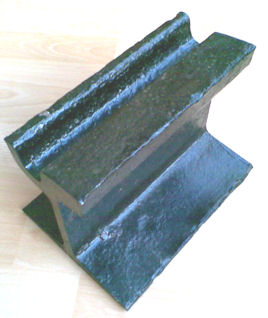 Fountain. The main tram-line ran straight along Main Street to Luss Road, and then turned down Balloch Loan to its terminus to the west of Balloch Station, between Lomond Villa and the Anchorage houses.
Fountain. The main tram-line ran straight along Main Street to Luss Road, and then turned down Balloch Loan to its terminus to the west of Balloch Station, between Lomond Villa and the Anchorage houses.
The lines were mainly single track with passing loops, with double track through the centre of Alexandria and at the termini. The tramlines at both Jamestown and Balloch stopped just short of the railway level crossings, which they were not allowed to cross. There were no signals nor points-changing except at the termini, so outside of the restricted twin line areas, passing took place on loops and this could slow journey times down considerably.
(The image above is of a section of the Balloch tram line kept by local man, the late John Ward. A few years ago some road works were taking place near where he lived in Balloch. The workmen dug up some of the old tram lines, which had been buried under the road. John asked them for this section as a keepsake.)
The Balloch - Dalmuir trams were green and cream coloured, double-decked “Glasgow Standard Tram” of about the 1901 vintage. They were built by Glasgow Corporation at its Coplawhill Works. Because the early Glasgow city routes went under a number of low bridges, they had no roof covering, and were therefore open to the elements upstairs. They could seat 25 inside and 30 on top and the trams had a top speed of 12 miles per hour. It took a tram about an hour and a half to get to Dalmuir, by which time a 1908 train passenger would already have been in Glasgow city centre for about 15 minutes, never mind Dalmuir. Also, in anything but good weather they were pretty uncomfortable to travel in, being open to the elements not only upstairs but also front and rear. By 1911 Glasgow had solved its upper deck roofing problems and introduced the Glasgow Vestibule Tram, which had an enclosed upper deck and was also enclosed front and rear, but the Balloch trams were never upgraded to such luxuries.
However, by the minor inconvenience of changing at Dalmuir Canal Bridge, passengers could travel by tram to and from Glasgow every day of the week. The trams were more frequent and cheaper than trains, and ran right past shops and houses with frequent stops, so in many ways they were also more convenient. It is unlikely that many people would have used them to travel all the way to/from Glasgow during the week. The tram was really for short, local journeys, which were the only sort that the majority of the travelling public took during the week at this time. The weekend was different, of course, and since the trains didn't run on a Sunday, people did travel between Glasgow and Balloch by tram on the Sabbath. And a great many of them did so. It is said that on the first Sunday of the new tram service to Balloch in mid-summer 1908, the trams brought in thousands of day-trippers to Balloch. Although they did not have the passenger-carrying capacity, or speed or comfort of the trains, they obviously offered a service that was in demand, and they ushered in an era of mass-tourism (on a Scottish scale) for Balloch.
Proof of this is evident just a couple of years later from the large crowds - between 5 and 10,000 - who attended the protest demonstrations on the banks of the Leven at Balloch in 1911 and 1912 on the Sweeney and Public Access disputes. Many in the crowds had come from Glasgow and were there because they were regular day-trippers who related, rightly or wrongly, to the issues in the dispute. Like most of the day trippers to Balloch, it is likely that their first stop on arrival at the tram terminus or Balloch Central station would have been at one of the boat-hiring stations on the west side of Balloch bridge.
(See separate contribution on Trams in the Vale of Leven)
Boating for the Working Man
Clan chiefs had galleys and boats on the Loch from time immemorial. By the 1800's they had been joined by Lochside landowners, the industrially wealthy. However, boat ownership did not extend to the working people, and the nearest a workingman got to a pleasure boat was acting as a gamekeeper who was rowing one. The first mention of ordinary people having a pleasure boat on the Leven and the Loch is in the 1820's. James Barr in his memoir tells how the journeymen in Levenbank Works pooled the annual fees they charged young men to be taken on as apprentices, and instead of having a ball or dinner as usual, decided to buy a pleasure boat instead. They wanted a craft that could carry a fair number of them, and found the answer in a ship's jolly boat that they located at Greenock. They got a steamer to tow it from Greenock to Dumbarton, and then towed it themselves up the Leven to its mooring at Balloch, where they christened it the Isabella. Although they didn't know it, of course, they and the Isabella had started something which has not only endured but grown to be a primary feature of Balloch and Loch Lomond - the working man (and it was exclusively man to begin with, although a few women featured they can safely be lumped with the gentry) and his boat on the Loch. In fact, these Levenbank owners of the Isabella can lay reasonable claim to this being the first purely pleasure boat acquired by working people in Scotland. Again they didn't know it, but they laid down another tradition - sailing out of the Leven and heading straight for Inchmurrin, partly because it was the nearest island, but probably more because the game-keeper on the island sold whisky - without a licence of course. A way of life was born. Slowly but surely over the years, more and more people who worked and lived locally acquired boats - either outright or had a share in one. Because there were comparatively few of them, they seem to have had no problem in mooring them in the river. Pictures from Balloch Bridge looking north to-wards the Loch even as late as 1911, show hardly any boats moored on the river. By the 1920's that has changed quite dramatically.
Boat Hirers
As more tourists and trippers came by train, they saw these locally owned boats being used by working men and they too aspired to get in a boat and mess about on the river. The rowing boat-hiring business came into being in the 1880's. The first of the boat-hiring businesses was founded by Harry Lynn on the west bank of the river, just north of Balloch Bridge, conveniently close to the station. Apart from anything else you didn't have to cross Balloch Bridge and therefore pay a toll to get to it. The proximity to the station and the avoidance of the bridge toll which was levied until 1895 was why all of the initial boat hiring businesses were on the west bank, cheek by jowl with each other.
Harry Lynn had spent most of his working life on boats on the Leven and Loch. From the mid 1850's he worked on a steam launch that towed barges and scows on the Leven and Loch. By its nature, that business also included an element of boat building. However, the Leven barge and scow business largely lost out to railway wagons, but Harry Lynn spotted an opportunity serving the less wealthy tourists who wanted an affordable trip on the Loch, and a “shot” at rowing. In the 1880's he set up in business as a boat-hirer, taking passengers for a trip on his steam launch and as a boat builder. A new line of business was born at Balloch, one in which the Lynn family participated until the early 1970's, when they sold their boat business to Nigel Stead.
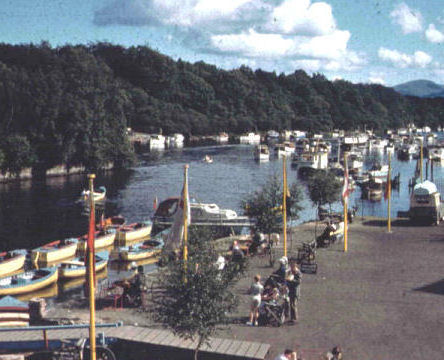
A rare photo of Lynn's boatyard after it had been tarted up in the late 1950's - early 1960's. Things to note are that the shore has been built up to an embankment - well before the present one - and the lines of self-drive motorboats for hire which replaced the rowing boats.
It was no surprise when competition arrived in the shape of John Sweeney, who until then had worked in the Craft. He opened up his own boat hiring business just north of the Lynns. Sweeney started in the late 1880's from a jetty just south of where the Humane Society boathouse is now, on land on which his great grandson still operates Sweeney's Cruises (although it has not been in the family's continuous possession from the 1880's). He, too, hired out rowing boats and took visitors on short cruises on the Loch using two coal-fired steam launches. Its fair to say that both businesses boomed in Balloch's summer season, attracting large crowds to the banks of the Leven, and continuing the tradition started by the steamers, of touting for business around Balloch Bridge.
By the early 1900's, other boat hirers had joined the fray. Harry Lynn's original business had passed to his sons, Tom and Isaac, on the south side of the bridge, but still on the west bank, a Mr Walker operated a motor launch for a time.
About 1911 the Lynns and John Sweeney were separately involved in two apparently contradictory disputes about their boat hiring businesses. The better known of the two is the Sweeney Case. At stake was a fundamental issue about freedom of navigation, although that is not how it played out in public. John Sweeny had moored a jetty to the bed of the river, and in the stream, without reference to the owner of the riverbed, James Campbell of Tullichewan. Campbell said that this was an obstruction to navigation, which could not be allowed, and that no one, not even him, could interfere with navigation in this way. Sweeney disagreed and the matter headed for the courts. Before it got there, the public had been encouraged to see this as a David (Sweeney) versus Goliath (Campbell) issue. Public meetings and demonstrations attended by up to 10,000 people were held, and the issue was portrayed as freedom of access for the general public. This was a travesty of the facts, of course, because what was interfering with the public's right of access was the jetty. The legal issue was absolutely cut and dried, as John Sweeney had been well warned by his many friends beforehand. He lost and had to remove the mooring. However, James Campbell was a decent man whose views on life in general were very similar to John Sweeney. Sweeney family tradition says that Campbell knew that the costs of the case would probably put Sweeney out of business, and that Campbell picked up not only his own costs but those of Sweeney as well. When the dust settled, the two became friends.
The Lynn case was, if anything, even more irrational. Tom, one of the Lynn brothers, decided it made sense to open a yard on the east bank in front of the Balloch Hotel, on land owned by the Hotel. This land, as any picture of the time shows, was accessible to the public up to the White Dyke, which was owned by the Dennistoun Browns of Balloch Castle, and about which there had been 50 years of dispute. However, the White Dyke in no way featured in Lynn's plans, Tom just wanted an open yard similar to the yards on the west bank. The right of the public to stroll through it was more important to him than it was to the public, because that was how he would get business. The public, still wound up from the Sweeney case, took a contrary view, which makes you wonder. Again demonstrations were held, this time against the new yard. Tom Lynn backed off, tempers cooled, bigger issues such as the First World War appeared and a few years later it was generally agreed that a yard on the site constituted no threat to public access at all, so Tom got the yard which he and his son occupied until the 1960's.
A little bit later than this, probably just after the First World War, a second boat-hiring business was established on the east bank just to the south of Balloch Bridge, which until then had been a marshy field. Bob Roxburgh, who had operated cruises from Balloch Park jetty, started this venture. Roxburgh's yard occupied the largest land area of any of the boat hirers, and its outline is still quite recognisable to day. Roxburgh sailed two streamlined motor launches, the Sunflower and Mayflower, which were in operation until the 1960's when they were still as eye-catching as ever with their swept-back Thames cruiser appearance, two smaller motor launches / speed boats as well as some rowing boats. In the late 1920's - early 30's Roxburgh sold out to Maggie Sweeney who had succeeded John. She sold the west bank yard and moved over into what had been Roxburgh's yard. She in turn sold that yard to the Blairs who operated it until the 1950's when it passed into Harry Lynn's hands.
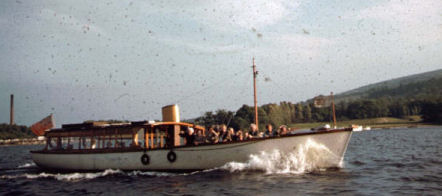
The old Queen of the Loch just leaving the mouth of the Leven. This was the first metal hulled cruise boat out of Balloch, brought onto the Loch by Blair's yard, and driven by George Cowan. It was the biggest cruise boat until Harry McGhee's water buses came along. Again, quite a rare photo to see her on the Loch carrying passengers.
The last person to start a cruise business on the Leven was Harry McGhee, who bought Lennoxbank House from Paddy Caulfield of sand quarry fame, around 1960. He converted it to the Lennoxbank House Hotel and at the same time installed an extensive jetty alongside the hotel ground's frontage, parallel to the river. In a move that reflected his ambitions more than economic reality, he commissioned and imported two brand new boats from Holland, which would sail from this. These boats were essentially Amsterdam canal cruise boats - flat-bottomed, glass-roofed with bus style leather seating. They were the first completely new boats to be bought for Loch cruising in more than half a century. They were named Lomond Princess and Lomond Duchess. The cynics up and down the riverbank prophesied all sorts of doom for them - particularly the ability of flat-bottomed canal boats to handle the potentially rough and unpredictable weather of the Loch, and the stress on the engines of river and Loch conditions as opposed to flat, still Dutch canals. Another complaint was that they were too modern and comfortable for west of Scotland customers who, it was presumed, preferred the more traditional existing boats with wooden seats and exposure to the elements. In fact both hull shape and the engines handled the sailing conditions without any noticeable problems. The gearboxes were another matter, and never performed satisfactorily. However, the cynics were spot on about one fundamental problem - these boats never generated enough paying customers to make money. When the initial burst of curiosity subsided - which it did within a season or so - it was obvious that the existing boat hirers at the Old Bridge, with their superior location for catching passing trade, and their existing contacts, were best placed to attract what were in any case falling numbers of customers. By the late 1960's the Lennoxbank operation had ceased, and the boats sold.
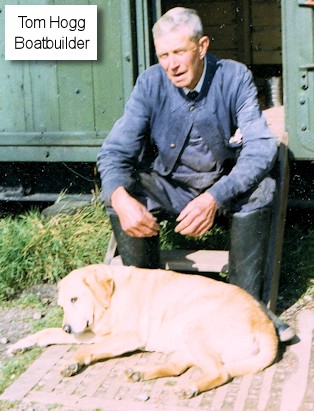 There were two other Balloch boat-hiring businesses, based on the Loch, rather than the Leven, which operated in the first half of the 20th century. The first of these was based at Balloch Park jetty. It didn't start until after Glasgow Corporation had acquired the Park from the Dennistoun Browns in 1915, and sailed on until the late 1950's when the Corporation closed it down as totally uneconomic - which it probably always had been.
There were two other Balloch boat-hiring businesses, based on the Loch, rather than the Leven, which operated in the first half of the 20th century. The first of these was based at Balloch Park jetty. It didn't start until after Glasgow Corporation had acquired the Park from the Dennistoun Browns in 1915, and sailed on until the late 1950's when the Corporation closed it down as totally uneconomic - which it probably always had been.
The other Loch-based boat yard was Hogg's in Drumkinnon Bay. Because of the changes allowed to the shore-line for the Lomond Shores development, the exact location of Hogg's yard no longer exists, but it was in the bay immediately in front of where the Tower now is, which was created by excavation, but which was previously a field. Hogg was a boat builder and repairer who rented out boats, usually to anglers. He went out of business shortly after the Second World War.
Private Boating on the Leven and Loch
The tradition of the working classes “having a boat on the Loch”, which began with the Isabella, had created a very strong sense of a river-based community with its own camaraderie and customs by the early 20th Century. Immediately after the First World War, this community of boat owners and users grew substantially, and by the 1920's and 30's a boat-based way of life was well established at Balloch for a great many people. During the Depressions of the 1920's and 1930's, the boats on the Leven provided the only break for many families in the west of Scotland.
The growth in the number of boats on the Leven in the early 1920's was quite stunning. The local council conducted a survey of the cabin cruisers and houseboats moored on or beached beside the River Leven at Balloch in July 1925. That survey estimated that 350 people were living in 126 craft. This is probably more than actually lived in Old Balloch at the time, but it may well be right, since it was at the height of summer, with the various Clydeside Fair holidays being in their heyday. An aerial photograph from about the same time shows about 170 craft on the Leven, and its evidence sharply contrasts with the practically bare banks of the river in the pre-war period. By this time, too, people were beginning to live all the year round in houseboats on or beside the Leven, while a few people lived in cabin cruisers on the river. An estimate puts the permanently inhabited houseboats at about 15 in the 1930's.
People who were brought up in houseboats included Duncan Mills, County, District and Regional Councillor, and first vice-chairman of the Country and then National Park, after whom the National Park's boathouse at Drumkinnon Bay is named. Duncan was immensely proud of the fact that he had spent much of his early life in a house-boat, winning many an argument about the Loch with the unanswerable comment “You might think you know about the Loch, but I lived every day of my life on it for more years than you've even known where it is”.
Some people stayed in the houseboats because they couldn't get any other accommodation, but most probably stayed by preference. Even in the 1950's and 60's when the housing shortage in the Vale had largely been solved, there were still about 10 houseboats and about 5 cabin cruisers in more or less permanent occupation. Some of these houseboats were towed to other moorings on the Loch such as Aldochlay, while others were simply scrapped. Now there are no houseboats (although one land based one survives as the polished wooden cabin in John Sweeney's yard), and no one lives permanently on the River.
From the 1920's onwards, there were a number of well-known characters on the river, and weel-kent boats. The “Redskin” was perhaps the best known. His nickname was derived from his well-tanned skin, which he got by rarely wearing a shirt. Although he had a house and family in Govan Drive, he was usually to be found on the banks of the river, or on a small cabin cruiser that he owned. The Loch Sloy, whose owners included the Sweeney family as well as Bobby Shearer of Rangers and Scotland, was probably the flag-ship of the Balloch fleet from the 1940's to the 70's.
Modern Day Changes in Balloch
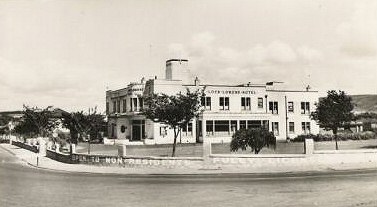
The Old Loch Lomond Hotel is now an apartment building known as Laudervale Gardens
The first major change to the area in the 20th century was building of the “New” or Carrochan Road between Balloch and Jamestown in the mid 1920's. Shortly thereafter, in 1928, the trams gave up the unequal struggle against motor buses, the service closed and the lines and poles were removed. The increase in bus services created a need for a bus terminus in Balloch - initially the terminus was an ad hoc one at the gates of Balloch Park. The building of the New Road created access to a space, which then became Balloch Bus Stance, the terminus for buses to Glasgow, Luss, Balmaha and Drymen.
In the 1930's another new road was built across Balloch, this time from Mill of Haldane across the Leven on a New Bridge to terminate at Luss Road. This was Lomond Road. Within 10 years, a new road system had been built in Balloch that substantially improved road transport and access to the village.
Lomond Road became the access point to the Balloch half of the Hostels, which were built about 1940 to accommodate war workers who came to the area, mostly to work in the Torpedo Factory. Immediately after the war, these Hostels housed eastern European refugees, or “Displaced Persons” as they were called, for a few years. Eventually the Hostels were demolished, to be replaced by the Dalvait Estate in the early 1970's.
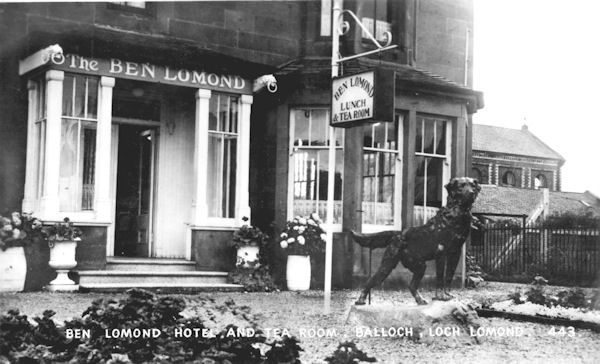
In the late 1940's Fredrico Arcari arrived in Balloch. He acquired much of the property of the Nairn Marshall family, including Dalvait House and buildings on the Front of Balloch. At the front of Balloch he opened a café and then his eponymous ballroom, for which his name lives on. In fact, Arcari's Ballroom, which was the centre of social life for much of the younger generation in Balloch in the 1950's and 60's, had a shorter life than just about anyone remembers. It was not quite 20 years old when it burned down and was not replaced, although Fredrico had departed some time before the fire. His use of Dalvait House was really bizarre. Not only did he allow it and the gardens to become derelict, his main use for this fine mansion was as a kennel for his greyhounds. Little wonder that it had been demolished and the land sold off by the 1960's.
The greatest 20th century change to Balloch was the building of the Haldane Housing Estate. This started in about 1953, with the first residents occupying the new houses in 1954. This more than doubled the size of Balloch's population, but had remarkably little impact on most other aspects of life in Balloch. True, the buses and trains got busier, and the bars in the local hotels certainly fuller, but little by way of infrastructure or facilities were added.
John Lawrence bought Mollanbowie Farm in the late 1950's and started to build what was initially called the Castle Avenue Estate, after the first road to be built there. The estate was gradually expanded northwards over a number of years. During that time a small private estate was added at Mossburn Avenue, which was a sort of offset for the demolition of the old houses between Mollanbowie and Stirling Roads.
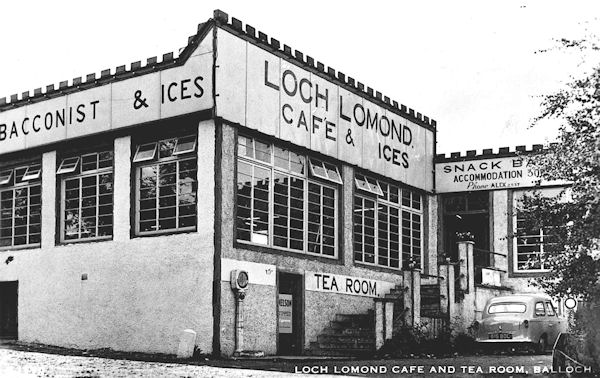
The site on the opposite side of Drymen Road from the Mollanbowie Estate was built in the late 1970's. In the early 1970's, the site of the Red Fox Nursery between Lomond Road and Bankhead was sold for housing, and the Red Fox estate was built. Shortly afterwards the Craiglomond Estate was also built. Balloch seemed to be running out of sites for new housing, but then the Silk Factory shut in 1980, and part of the site was earmarked for housing. In fact, it was many years until the site was developed as Clairinish. At about the same time, Dalvait Gardens were built on the site of the old Nairn Marshall property in Dalvait Road, and that was just about it as far as development sites in Balloch were concerned.
Balloch has continued as a place where people come to play. The Balloch Highland Games (now known as the Loch Lomond Highland Games) were started in 1967 in the Moss o Balloch Park and now have a very successful event in Balloch Park, on a site that has been well used by rock bands as an arena event. Indeed the slope down from Balloch Castle provides an excellent natural arena. The first group to play Balloch Park was Runrig who performed to an audience of 40,000 in June 1991. The show was judged a great success, but there was considerable trepidation among some locals it was announced that Oasis was to perform there over 2 days in August 1996. Again, it was great success with 80,000 people attending and Balloch Park seemed to have arrived as a venue. In fact was another 9 years before REM staged the third concert in the Park. In 2007 the BBC launched its first Live at Loch Lomond festival, and the second is scheduled for August 2008.
Moss o Balloch has been used for some years, on a more modest scale, of course, as the venue for a very successful annual Folk Music Festival.
On the same day in 2002 Lomond Shores was opened at Drumkinnon Bay, and the Scotland's first National Park came into operation. The new headquarters of the National Park has just opened in May 2008. The predominant colour of the building, on a prominent site at the junction of Lomond and Carrochan Roads, Balloch, is grey, that well known Vale colour.
Page 1 | Page 2 | Page 3 | Page 4


